Gunnison Public Lands Initiative
Via email only @ info@gunnisonpubliclands.org
RE: Gunnison Public Lands Initiative
Dear Sirs;
Please accept this correspondence as the preliminary input of the above Organizations vigorously opposing the Gunnison Public Lands Initiative (“The Proposal”). The Organizations general concerns are generally summarized as follows:
- While the Proposal asserts there is no lost opportunity for the motorized community, this position simply lacks any factual basis as the Proposal closes extensive portions of the planning area currently open to motorized usage;
- The Planning area is not the basis for significant conflict in the recreational community, but the Proposal would create immense conflict for the future of these areas;
- The extensive conflict between the Proposal and existing federal laws for management of many of these areas that resulted from extensive consensus processes previously;
- The complete lack of scientific basis for much of the recommended management;
- The complete failure to relate management standards to on the ground conditions as exemplified by conflicts in forest health management treatments; and
- Claims of balance in the Proposal are not supported by management standards for most areas.
The Proposal appears to start with the position that the entire Gunnison Valley is suitable and available to be designated as Wilderness and asks the public to provide reasons that areas should not be designated as Wilderness. In a troubling turn of events, there is simply no effort provided in the Proposal to outline current management of areas and any priority management issues in the areas and as a consequence the Proposal would have significant negative impacts on the issues that it is alleged to be addressing. The Organizations must question the value of any public input received as the public is forced to perform hours of research simply to understand the change in management for the area under the Proposal. While the Proposal asserts balance in the Proposal, the Organizations are simply unable to identify a single benefit to the multiple use community as a huge number of the management areas would result in the immediate loss of existing opportunities for multiple use and more troubling, almost every area currently discussed places a cap on existing abilities to expand or improve multiple use opportunities for access, such as Crystal Peak, Lotus Creek, Union Park, East Gunnison, Matchless and many others.
The Organizations have participated in a large number of consensus efforts over the years and throughout these efforts current efforts on issues have always displayed a high level of respect for the conclusions of previous consensus-driven efforts, which has not been displayed here. In addition to failing to provide any benefits to the multiple use community, the Proposal fails to address many of the protections and other management standards that have resulted from previous consensus-driven efforts, such as those that resulted in the 1980 and 1993 Colorado Wilderness Legislation. Public input has also been consistently provided regarding the management of much of the Gunnison Valley in NEPA processes that have guided planning for public lands in the area for decade. NEPA processes with the USFS have always been successful in obtaining public input and the failure of the Proposal to address this public input is deeply troubling. The Proposal also fail to address existing federal laws that are in place in these areas and as a result many of the Proposals standards and basis for area designations are now directly in conflict with these laws. The Organizations must question the validity of any consensus process that does not comply with federal laws as we have found the desire to comply with federal law an issue where a high degree of consensus is always achieved in the collaborative process. A project that seeks to develop public consensus management for the area that does not start with the consensus management recommendations already in place is off to a troubling start in our position.
The Proposal simply lacks any factual examination of proposed standards and the on the ground conditions in the area. This is exemplified by the fact that the Proposal identifies climate change impacts on habitat as a major concern for the Proposal but fails to relate what is a small land management proposal in Colorado to any identified impact to a global challenge. The failure to meaningfully address the basis for designations has resulted in concrete challenges that are directly degrading habitat in the Proposal area, such as the impacts of pine and spruce beetle on a huge number of trees in the areas actually more difficult to address. Again, this draws the management decisions made in the Proposal into question and directly conflicts with the recommended management standards for many of the species in the area, such as cutthroat trout and other goals of the plan, such as protecting water quality.
1. The Organizations collaborate with diverse interests throughout the state on trails projects.
Prior to addressing the specifics of our concerns around the Proposal, the Organizations believe it is important to explain our history and background on working on tough issues with a diverse range of interests with public land managers throughout the state. Even in situations where other user groups have not become involved in discussions for reasons that remain unclear, the Organizations have strived to achieve benefits for all interests and users. A list of a few of the examples of our recent collaborative efforts include:
- SB 17-100- The Organizations spearheaded passage of this Legislation in 2017 that significantly reduced the liability for clubs performing stewardship actions on public lands in Colorado, while the legislation protected all users the only group that showed up and supported these efforts was the Nature Conservancy;
- CPW LEAN Event – This was almost a years’ worth of collaborative efforts from the Organizations with CPW, State Treasurers Office and numerous others regarding how to achieve more timely implementation of grants from the trails program and as a result of these efforts all grants are now available to the applicants almost 1 year earlier than before the LEAN event, while these efforts again benefitted all grant applicants there was no support from any other user groups;
- Tenderfoot Mountain Project on Dillon Ranger District– trail was constructed to benefit a wide range of interests including motorized and mechanized users with improved wildlife habitat in the area after years of collaborative meetings, this project remains ongoing but has extended more than 5 years;
- Bear Creek Trails Project on the Pikes Peak Ranger District – where an entire trail network was moved and rebuilt from scratch to address generically pure cutthroat trout habitat being impacted by the existing trail next work- this took more than 4 years;
- Hermosa Watershed Legislation outside Durango– here first of its kind federal legislation resulted from years of collaboration of interests ranging from water, ranching, local government, snowmobile, summer motorized and mechanized and the Wilderness Society and this effort took almost a decade;
- Badger Flats Campground project on South Park Ranger District – the Organizations collaborated with the Wilderness Society, campers, local property owners and other interests to renovate a poor managed area into a regional trails hub and camping facility with an extensive multiple use trails network effort here remain ongoing but have already covered more than 5 years;
- Bangs Canyon SMA outside Grand Junction – a collaborative effort spanning more than a decade on GJFO where again a diverse range of interests collaborated to develop a multiple use area that also improved wildlife habitat and protected cultural resources and this project has taken more than a decade;
- 667 Trails Projection Pikes Peak Ranger District– restoration of a heavily used trail network lost in Hayman Fire and then heavily impacted by flooding which took almost 20 years to complete;
- Hartman Rocks area on the Gunnison BLM Field Office – a multiple use were ongoing efforts longer than a decade have leveraged resources to develop a unique trails-based recreation area that has been highly successful;
- Canadian Lynx research with USFWS- in this project CSA partnered with the USFWS to facilitate targeted lynx research by providing resources and expertise to researchers working to understand the relationship between lynx habitat and recreation. This support ranged from removing snowmobiles broken or stuck in the backcountry during blizzards with CSA grooming equipment to oil and gas for basic operation to educating researchers how to ride and operate equipment in the backcountry.
The Organizations are proud of the history of collaborative projects that has been developed across often wide interest’s groups with benefits for all parties involved. In these efforts, often laying the groundwork has been very slow and often verging on shaky but throughout these efforts the strong foundation has been important in uniting the groups and interests as the projects moved forward and resulted in quality projects being developed and being successful in the long run.
The Organizations would also note that even in situations where other groups could be excluded from benefits of collaborative efforts because of their failure to become in any manner in the discussions or efforts (such as SB17-100, CPW Lean, Lynx research) these groups have not been excluded. Rather than pursuing true collaboration in the Proposal, such as would be provided in a complete review of existing planning and Legislative efforts, the interests of a single group have been placed above all others and pushed forward at breakneck speeds. Rather than a strong foundation resulting from the shaky slow start, this collaborative effort appears to be put at risk for reasons that simply make no sense to the Organizations.
1b. The Colorado Trails Program protects resources and benefits all users.
In addition to the above collaborative projects, the Organizations have supported the development and implementation of the voluntary registration programs for both summer and winter recreation that is coupled with the funding from the Federal Recreational Trails Program. This program provides almost $8 million (or $1.25 for every resident of the State) per year for trails of all kinds which is almost entirely funded by the motorized community for more than 20 years. The motorized portion of the program provides for almost 60 maintenance crews based throughout the State which are well equipped for both summer and winter maintenance needs. This program actually protects resources in a proactive manner, and this benefit would be lost when trails are closed to multiple use. This program maintains routes for the benefit of all users, as all motorized roads and trails are open to all other forms of recreation and this funding is now critical in providing basic access due to among other things, the Gunnison Valley being some of the hardest hit areas in the country in terms of mountain pine beetle and spruce beetle infestations.
The lion’s share of the projects is now directed towards basic maintenance of existing facilities for a variety of reasons including decades of communication with USFS and BLM staff which have consistently identified that proving basic maintenance is the most effective manner to keep routes open. The importance of the $4.3 million to USFS recreational budget is reflected in the tile below from the 2015 OHV workshop presentation from the USFS:
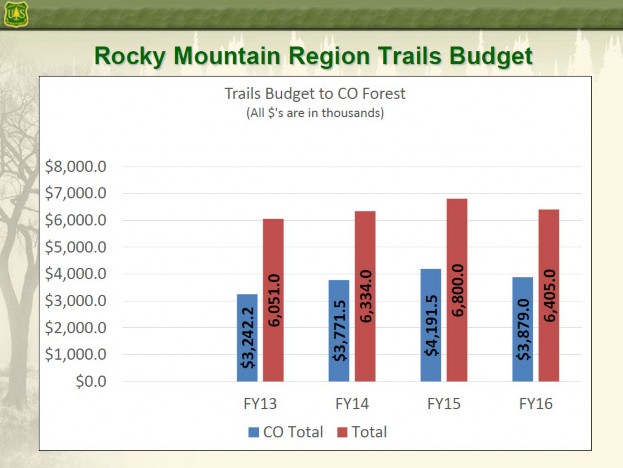
In addition to the $4.3 million in OHV funding the funding is leveraged with an additional $1.1 million dollars for winter recreational route maintenance and almost $2.4 million in funding for maintenance for non-motorized recreation. The Program is providing a massive portion of the funding for basic recreational activity on USFS and BLM lands in the State of Colorado, the motorized community has also been repeatedly identified in Volunteer Stewardship reports prepared by the State of Colorado as the single largest source of volunteer support for trails in the State. Failing to address these direct benefits of multiple use access in the Proposal is unacceptable as there are 3 maintenance crews for summer usage and 2 winter recreation working the Proposal area to protect resources in addition to providing millions for maintenance on an as-needed basis for further leveraging of these maintenance crews.
2a. Public input process is in need of improvement.
As the Organizations have noted above, the Organizations are heavily involved in a wide range of collaborative efforts on often wide-ranging and difficult topics. It has been the Organizations experience that often the process relied on to develop a consensus position for these challenging issues tells the story as to the value of a minority position or the desire to truly seek consensus. When consensus or balance in the development process is not meaningfully addressed, the end result often directly contradicts the basic purpose and need for the project and does not represent viable balanced position. Rather than consensus of all users, the failure to address minority position concerns results in a weak foundation for the proposal and the views of a small cross-section of the interests in the proposal. The impacts of failing establish a proper foundation on large-scale planning can be seen with the complete failure of the Desert Renewable Energy Project in southern California to approach consensus and resolution of the goals and objectives of that effort. This should be avoided.
This is the first concern with the GPLI as while we have not participated directly in the meetings, our Organizations have received many questions regarding the process from those that have attended the meeting, both as members of local clubs and as members of the public. Often the response from these attendees has not been positive regarding the meeting process and engagement of the general public that is attending. That is concerning as many of the public may be deeply interested in an issue but also have traditional employment situations and are not able to attend extended meetings during the day on any issue. Generally, the public needs to take time off from work to attend meetings and as a result they may only be able to provide limited input. Any collaborative process should be geared to address this situation and given the response from our members this type of input is not well received.
Our process concerns around development of the Proposal are emphasized by the fact that there are no meeting minutes are available for the public to review regarding the basis for the Proposal. Providing this type of basic information about the proceedings would be critically important in developing true public input as many of the public simply will not be able to attend meetings in person for a variety of reasons. This type of general information on the Proposal would be highly valued by the public in identifying factors or information that might have been overlooked it the development of the Proposal. Again, this is basic information that should be available to the public for inspection if collaboration and public input is actually being sought.
2b. Participation does not always mean support.
As the Organizations have stated previously, a complete representation of all interests in collaborative efforts is critical to developing a balanced proposal. The Organizations are very concerned that much of the public participation in the process is being misunderstood as support for the Proposal, especially from the motorized community, as reflected by the numerous pictures of motorized usages that are spread throughout the Proposal. Many of the members we have spoken to about the Proposal are simply opposed to the recommendations completely. There is a significant difference between participation and support and often the Organizations participate in processes that will never be supported by the membership. There is also a significant difference between seeking a group support and actually obtaining that groups support. The need to comment on such basic issues again makes the Organizations concerned that there is very little interest in developing a consensus position but rather the interest in the Proposal is seeking to create the appearance of public support for a decision that has already been made. These are two very different processes and basis for seeking public consensus.
3a. Many of the foundational assumptions are simply incorrect regarding OSV travel in the area.
Throughout the Proposal, numerous assertions about possible impacts to various recreational activities are made without any basis for such positions, such as the assertion that the Proposal does not affect popular over the snow riding areas.1 CSA submits this position is completely inaccurate and much of the designations in the Proposal would close highly valued recreational areas for the OSV community. This is highly frustrating to the OSV community as we have worked hard to collaborate with many of the same interest groups and people participating in the GPLI process to develop collaborative management on the GMUG for OSV usage that satisfied a broad range of interests and users. For those efforts to now be simply cast aside is highly frustrating and causes us to question why we would ever get involved in collaborative efforts to resolve issues, when the partners in those efforts simply cast the conclusions and effective management conclusions that have been reached so easily.
The map below is the current OSV travel restricts from the USFS and the systemic conflict between this decision document and any assertion of consistency of the Proposal is immediate. 2
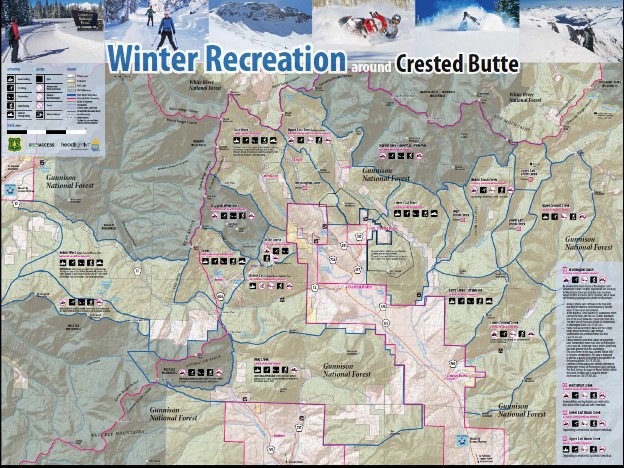
While the above map addresses collaborative efforts in the Crested Butte area with the USFS, this is by no means the only location the OSV community has collaborated on in Gunnison County.
A complete review of the GMUGOSV planning that has been done to date is available on the USFS website.3 AAt no point in the discussions is there any analysis regarding the current management of any of the proposal areas but rather the discussion starts from a position that there is no conflict with the Proposal and current management. This failure to address the current management of these areas is highly frustrating as the GMUG has along a successful history of collaboratively addressing OSV travel in the Proposal area. The Organizations submit that the complete lack of factual accuracy around the position that the Proposal does not close OSV areas is troubling at a minimum.
3b. Many of the foundational positions are simply incorrect regarding OHV travel in the Proposal area
The complete lack of factual basis for many of the assertions made in the Proposal is also exemplified by the analysis of multiple use summer recreation is exemplified as the Proposal starts from a position that no roads or trails will be closed by the GPLI proposal4. Again, no basis is provided for this position and the Organizations vigorously assert that this position entirely lacks merit, as the Proposal would have a massive impact on future development of OHV roads and trails. Many of the areas addressed in the GPLI are currently managed for the long-term expansion of multiple use recreation. Even in SMA areas whereOHV usage is addressed, each of these areas provides for a cap on any expansion in terms of mileage but fails to provide any protection for the levels of activity that are currently allowed and have been occurring for an extended period of time without issue.
These failures in the factual analysis are deeply troubling as the message from the consistent assertion of inaccurate information on recreational activity would be that motorized access to the Gunnison Valley was the single largest threat to resources in the valley. Clearly, that issue is not supported by factual analysis given that the northern portions of the Gunnison Valley are some of the hardest hit in terms of poor forest health as in many areas, tree mortality has easily exceeded 50% kill rates and is significantly higher in many locations.
3c (1). Much of the Proposal directly contradicts with federal law for the management of Proposal areas.
The lack of factual consistency of the Proposal with the broad and vigorous history of collaboration in the Gunnison Valley is not limited to motorized recreational issues, as the clarity of previous Congressional actions addressing public lands in Gunnison County is also not addressed. Rather the Proposal appears to simply start from a position that Congress has not spoken on the management of these areas and that these areas are not currently the basis for the previous Congressional decision that sought to bring balance to previous consensus positions for these areas. There is a long and highly specific history of Congressional action on these areas and the extensive discussions that have taken place trying to provide some type of balance in the usage of areas not designated as Wilderness. The Organizations must question the value of any consensus process that does not recognize the value in the determinations of consensus and community groups that is previously been undertaken.
The high levels of clarity around previous Congressional actions addressing public lands in Gunnison County is exemplified in the 1980 Colorado Wilderness Act that created the Colligate Peaks, Raggeds and Fossil Ridge Wilderness areas. The 1980 Colorado Wilderness act specifically spoke of the need to protect multiple use in areas it was not designated as Wilderness as follows:
SEC. 101. (a) The Congress finds that-
(1) many areas of undeveloped National Forest System lands in the State of Colorado possess outstanding natural characteristics which give them high values as wilderness and will, if properly preserved, contribute as an enduring resource of wilderness for the benefit of the American people;
(2) the Department of Agriculture’s second Roadless Area Review and Evaluation (RARE II) of National Forest System lands in the State of Colorado and the related congressional review of such lands have identified areas which, on the basis of their landform, ecosystem, associated wildlife, and location, will help to fulfill the National Forest System’s share of a quality National Wilderness Preservation System; and
(3) the Department of Agriculture’s second Roadless Area Review and Evaluation of National Forest System lands in the State of Colorado and the related congressional review of such lands have also identified areas which do not possess outstanding wilderness attributes or which possess outstanding energy mineral, timber, grazing, dispersed recreation and other values and which should not now be designated as components of the National Wilderness Preservation System but should be available for nonwilderness multiple uses under the land management planning process and other applicable laws……
(b)(2) The purposes of this title are to…….. Ensure that certain other National Forest System lands in the State of Colorado are available for non-wilderness multiple uses.”
Additional clarity regarding the desire of Congress to return multiple use to areas that were not designated as Wilderness in the 1980 legislation is also provided by Section 107 of the 1980 Colorado Wilderness legislation, which clearly states as follows:
“(3) areas in the State of Colorado reviewed in such Act; for study by Congress or remaining in further planning upon enactment of this Act need not be managed for the purpose of protecting their suitability for wilderness designation pending revision of the initial plans; and”
Given the long history of clear Congressional action regarding the management of so much of the Proposal area, the Organizations must question what has changed in these areas and why would the previous consensus positions now need to be changed in terms of management of these areas. Clearly these previous Legislative actions developed high levels of public participation and consensus and should be honored. The fact that one group did not get exactly what they wanted in consensus efforts previously does not create the need for new consensus efforts without a serious change in the circumstances in the area.
3c (2). Fossil Ridge Recreation Management area
The failure to address previous Congressional actions in the Proposal area is highlighted by the fact that the Fossil Ridge Management area prescriptions are simply never addressed in the Proposal. These concepts were again specifically included in the 1993 Colorado Wilderness Act, which designated the Fossil Ridge Wilderness. The 1993 Colorado Wilderness act also specifically created the fossil ridge recreation management zone, which specifically addressed multiple use recreational access in the SMA as follows:
“(g) OFF-ROAD RECREATION. —Motorized travel shall be permitted within the recreation management area only on those established trails and routes existing as of July 1, 1991, on which such travel was permitted as of such date, except that other trails and routes may be used where necessary for administrative purposes or to respond to an emergency. No later than one year after the date of enactment of this Act, the Secretary shall identify such routes and trails and shall prepare and make available to the public a map showing such routes and trails. Nothing in this subsection shall be construed as precluding the Secretary from closing any trail or route from use for purposes of resource protection or public safety.”
The current boundary of Fossil Ridge Recreation Management area is provided below:

In addition to the above protections the Fossil Ridge area is also the subject of extensive site-specific management areas standards.5 In a very troubling course of conduct, again these provisions simply are not addressed in the Proposal, despite being specifically provided for in two pieces of legislation more than 10 years apart and the result of extensive public input and collaboration in their development. The existence of the Fossil Ridge Recreation Management area should at least be addressed in the Proposal management zones in these areas but simply is never mentioned.
3c (3). Many of the Proposal areas directly violate Federal law specifically stating there shall be no buffer areas around many Wilderness areas.
As identified above there have been significant congressional actions to address the management of many areas within the upper Gunnison Valley for more than 50 years that are not addressed in the Proposal. The 1980 and 1993 Colorado Wilderness acts implemented additional protections for usages of areas outside the designated Wilderness areas with the addition of the “no buffer” concept to further protect multiple usage in boundary areas. Clearly, these “no buffer” protections were put in place to facilitate the consensus of multiple users and interests in these lands. The Organizations can see no reason why these consensus positions should be changed now. There are several areas in the Proposal such as Crystal Creek, Lottis Creek, Matchless and Signal Peak areas that propose to manage areas in direct violation of federal law addressing the areas. Fossil Ridge, Colligate Peaks, Uncompahgre, Powderhorn and Raggeds Wilderness areas were created by the 1980 and 1993 Colorado Wilderness Act both of which specifically subject to no buffer requirements provided in the pieces of legislation as the 1993 Colorado Wilderness Act as follows:
“(e) BUFFER ZONES. —Congress does not intend that the designation by this Act of wilderness areas in the State of Colorado creates or implies the creation of protective perimeters or buffer zones around any wilderness area. The fact that nonwilderness activities or uses can be seen or heard from within a wilderness area shall not, of itself, preclude such activities or uses up to the boundary of the wilderness area.”6
While existing federal law, reflecting the consensus position that was reached in the 1993 Wilderness Expansion Legislation, is exceptionally clear on the usages that are allowed outside these Wilderness areas and that there shall not be any buffers around these new Wilderness areas, the Proposal openly asserts that the basis for the designation of these areas is to provide a buffer for the Wilderness area.
An example of the cavalier disregard the Proposal has for previous consensus efforts now reflected in federal law is evidenced by the following statements around the Lottis Creek addition:
“Primary Issues, Concerns, and Opportunities
• Improved Wilderness boundary management for the USFS
• Wilderness characterRationalefor RecommendationThe Working Group is unaware of any existing uses that are not compatible with Wilderness in this area. A Wilderness addition would improve the integrity of the Fossil Ridge Wilderness, maintain the wilderness character of the area, and improve the ForestService’s ability to manage the existing Fossil RidgeWilderness.
Next steps
• This area is ready for a final review to ensure that the boundary is identifiable on the ground and that the designation will not have unintended consequences.”7
The Organizations vigorously assert that most of the Proposal designations are direct violation of federal laws developed and specifically addressing the Lottis Creek area and many others. Similar basis for designations and management are reflected in virtually every designation around the Fossil Creek Wilderness and other Wilderness areas within the Proposal boundaries but are not reflected here simply to avoid repetition. This is deeply troubling to the Organizations as most consensus efforts we have participated in start from a position that any recommendation be in compliance with relevant laws and regulations. It is even more troubling the large public efforts that surrounded these legislative efforts that are now simply being overlooked based on an assertion of seeking consensus.
3c (4). Congress has looked at many of the areas now proposed to be Wilderness and specifically spoke to why they were not designated previously, such as the northern boundary of the Big Blue/Uncompahgre Wilderness.
Congressional action regarding the management of public lands in Gunnison County has not been limited to the identification of usages in buffer areas and the release of proposed areas back to multiple use. The Organizations must highlight the exceptional detail that Congress looked at balancing usages and drawing boundaries for Wilderness areas in the southern portions of Gunnison County when the 1980 Colorado Wilderness Legislation was developed. House Report 96-617 provides a detailed analysis of why the northern boundaries of the Big Blue/ Uncompahgre and Powderhorn look the way they do. This report provides as follows:
“The committee feels the additions of these lands is vital to the overall integrity of any Big Blue Wilderness, and especially notes their outstanding scenic and watershed values. At the same time, the Committee recognized that the public currently relies on motorized access to certain key areas and therefore amended the Bill to exclude lands in the vicinity of Nellie Creek and to excise two road corridors which extend part way up the Middle and West Fork Cimarron River Drainages. Another boundary adjustment was made on the extreme western end of the area near Baldy Peak to exclude 15000 acres which are used by grazing permittee for frequent motorized access and intensive management……”8
The desire of Congress to address boundary areas with such detail is unusual and provides a compelling basis for the Wilderness designation boundaries being drawn in the manner they were. Clearly Congress anticipated discussions such as this occurring in the future and this explains why this information is recorded with such high levels of detail. In a troubling turn of events, many of the specific areas that Congress released in 1980 due to high-value multiple use interests are again being proposed as Wilderness as part of the Uncompaghre and Powderhorn additions. Not only does this violate the no buffer principals it violates the direct statements of Congress in 1980 that the public access to these areas was critically important.
3c (5). Wilson Mtn., Uncompahgre and Uncompahgre Contiguous Primitive areas were released in the 1980 Colorado Wilderness Act.
The Organizations would be remiss if the broad nature of the consensus process around both the 1980 and 1993 Colorado Wilderness acts was not discussed. The additional clarity of Congressional action regarding the desire to provide for future multiple use of the planning areas was provided for with the additional step of removing both the Wilson Mtn. and Uncompahgre Primitive area designations that had encompassed a large portion of Southern Gunnison County. The USGS inventory of these areas extended outside formal primitive area boundary as was directly evidenced by the inventory of the Uncompahgre Primitive areas adjacent process as well. Copies of these detailed reports are available upon request. As a result of the existence of these primitive areas before the passage of the 1964 Wilderness Act, these areas were also reviewed by the US Geological Survey and the Bureau of Mines. These detailed site-specific analyses were incorporated in the 1980 Colorado Wilderness Act as Congress clearly stated they balanced interest in the areas by drawing boundaries in the way they did as Congress felt the areas not designated as Wilderness were unmanageable due to the large number of private inholdings.
Again, Congress has clearly spoken about the desire to manage public lands in this area with the abolition of both the Wilson Mtn., Uncompahgre and Uncompahgre Adjacent Primitive areas with the 1980 Colorado Wilderness Act, and the Organizations can see no reason for this to change. These are issues that directly contradict the Proposal management recommendations and draw any assertion of consensus position into question.
4a. First round RARE inventory
Most of these areas were inventoried for possible roadless designations in USFS RARE inventory process and were subject to specific release by Congress in the 1980 Colorado Wilderness Act as previously addressed in these comments. It is significant to note that many of the uses that were found to be the basis for unsuitability in the original RARE inventories in the 1970’s and early 1980’s remains in these areas. Given these usages, the Organizations must again highlight how many determinations have been made against the recommended management for many of these areas in the Proposal.
4b. Most areas proposed to be Wilderness was found unsuitable for designation as Upper Tier Roadless areas in the 2012 Colorado Roadless Rule Process.
The Organizations were heavily involved in the development of the 2012 Colorado Roadless Rule, where both additional management flexibility was to be provided in Roadless areas and additional protection of less developed areas was explored. Extensive site-specific inventories of areas were again provided as part of development of the Colorado Roadless Rule to ensure that current information about any area was relied on in the inventory process. As a result of this process, significant portions of the areas now proposed to be Wilderness or the subject of other exclusionary management standard were inventoried for possible inclusion in upper tier roadless designations under the 2012 Colorado Roadless Rule development. Similar to the RARE inventory conclusions almost every area proposed to be Wilderness was found unsuitable for management as upper tier only a few years ago. The Organizations must question why the heightened restriction of Wilderness management is thought to be warranted, when lower levels of protection have already been identified as unsuitable several times.
In the Roadless Rule process, generally two categories of management inventory were explored, which were Colorado Roadless areas and Upper Tier Roadless areas. In an Upper Tier roadless area, management was closer to a Congressionally Designated Wilderness and in Colorado Roadless Area management direction was moved towards higher levels of usage and flexibility.
Under Alternative 2 (preferred) the designation of Upper Tier Roadless management is reflected in areas highlighted in yellow on the map below and alternative 4 of the Proposal provided a more extensive acreage of areas for possible upper tier designation, which is reflected in the red freckled areas on the map below. The stark differences between the scope of alternative 2 and alternative 4 of the inventory are reflected in the map below:
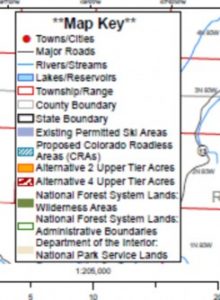
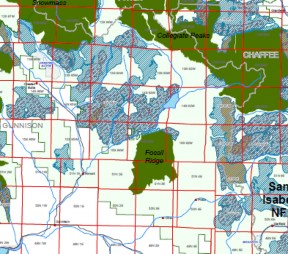
The Organizations must note that almost EVERY area now proposed to be Wilderness was reviewed under Alternative 4 of the Roadless Rule EIS and found to be unsuitable for this lower level of protection and management of an Upper Tier management designation. In the site-specific descriptions of each of these areas, a detailed discussion of the reasons for designation of these areas either as CRA or Upper Tier was provided. The overlap of the CRA process and RARE inventories conclusions is significant and weighs heavily against the Proposal and many management standards.
The Organizations must question any assertion that these areas are suitable for Wilderness designations when these areas were recently inventoried and found unsuitable for the lower level of protection provided by an Upper Tier designation. Any assertion of a factual basis for such management would not be supported by the extensive site-specific inventory and review that was created as part of the Colorado Roadless Rule development. The Colorado Roadless Rule process was another administrative confirmation that these areas do not warrant heightened protections and should be managed for multiple use.
5. Economics of Wilderness Recreation.
The Organizations are also very concerned that much of the Proposal management directly conflicts with best available science on issues. Our concerns on the basic conflict will be highlighted in comparing habitat issues and economics. The Organizations are aware that many counties in the vicinity have moved away from the dark economic times that plagued them several years ago, as exemplified by Summit County Colorado identification as number 3 on the Wall Street Journal list of 21st Century Ghost Towns.9 Unfortunately many communities outside the direct influence of ski area-based revenue continue to struggle and overly rely on recreational opportunities to provide basic services to residents. Many of these communities might include Paonia, Almont or Marble as examples. Given the importance of recreation to these communities and many of our members that live in these communities, the Organizations believe a brief update of the economic impacts to these communities that resulted from the Proposal is warranted. Significant new information identifies the strong negative relationship between Wilderness designations and local economic activity involving recreation.
The first piece of new scientific research is the local economic information from USFS, as part of their “at a glance” summaries for the GMUG National Forest, which identifies the overwhelming importance that recreation plays in the success of local communities. TheUSFS summarizes their conclusions in the following graphs10:
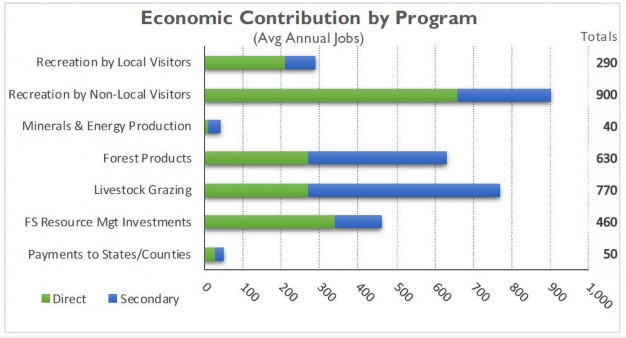
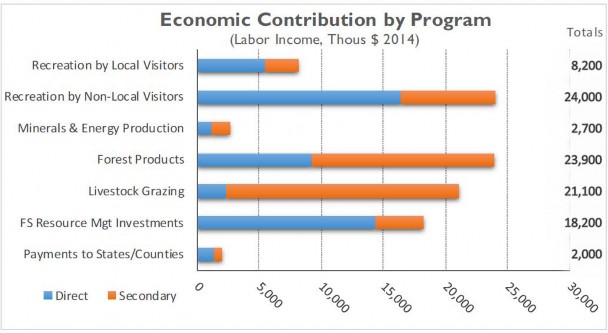
It is difficult to understate the importance of the economic contribution of recreational activity and other activities that would be prohibited in the Proposal to local communities, when the USFS estimates that the economic benefits of these activities outpace all other usages combined by a factor of more than 12.
New research highlighting the economic importance of multiple use recreation to the recreational spending benefits flowing to local communities comes from research from the Department of Commerce. This analysis was prepared at the request of Department of Interior Secretary Sally Jewel in 2012, addressing the importance of recreational spending in the Gross Domestic Product.11 This research clearly identified the important role that motorized access plays in recreational spending, which is summarized in the following chart:
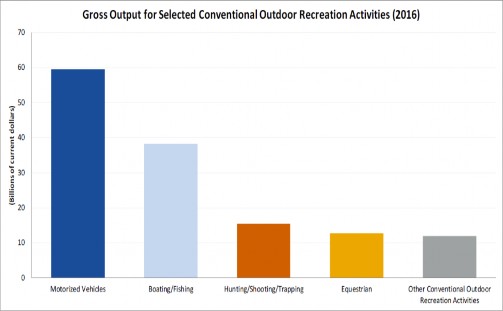
This research concludes that motorized recreation outpaces the economic contribution of boating and fishing at almost twice the rate and that motorized recreation almost outspends all other categories of recreation combined. Given that motorized usage plays major roles in both the hunting and fishing economic analysis, the three largest components of economic benefit from recreational activity would be prohibited in a Wilderness area. As a result of the overwhelming nature of these conclusions, the Organizations have to express serious concerns when the lion’s share of economic drivers are excluded from using any portion of public lands as clearly economic benefits are limited. The negative economic impact concerns regarding degrading multiple use access are immediately apparent.
The risk of negative economic impacts is also highlighted in newly released research from the US Forest Service, which estimates that recreation on National Forest Service Lands accounts for more than $13.6 billion in spending annually.12 Experts estimate that recreational spending related to Wilderness areas accounts for only 5% of that total spending or approximately $700,000 million nationally.13 The limited economic driver of Wilderness based recreation is compounded by the fact that more than 20% of the trail network that is currently located onUSFS lands is within Wilderness areas. Again, this type of underutilization of any recreational resource is concerning to the Organizations simply because of the allocation of the resources and funding. The basis for the underutilization of Wilderness based recreational resources is easily identifiable when USFS comparisons for economic activity of recreational users is compared in the research below:

We will not be addressing this research at length as we have included this analysis in our previous comments other than to note the conclusions of this research are consistent with conclusions that high spending user groups, such as snowmobile and OHV users are consistently excluded from Wilderness areas, while low spending groups such as cross-country skiers and hiker are permitted in these areas. Given the fact that low spending profile users are often spending only 20% of higher spending profile groups, these conclusions are consistent with the conclusions of both the Department of Commerce and new USFS research.
While the imbalance in spending profiles is problematic, the fact that once Wilderness is designated the general public fails to use the limited recreational opportunities in these areas is even more concerning. Nationally, congressionally designated Wilderness accounts for approximately 19% of USFS lands but results in only 3.4% of all visitor days.15 In the State of Colorado, there is approximately 22% of USFS lands managed as Wilderness16 but despite the expanded opportunity results in only 3.7% of visitor days on the GMUG National Forest.17 As we have noted in previous comments there are significant declines over time in the visitation to and demand for Wilderness based recreational experiences. Given the significant underutilization of Wilderness resources in the area of the Proposal, the Organizations must vigorously assert that any economic risk is significantly negative and must be addressed or at least recognized by the communities in the vicinity of the Proposal areas.
6a. Habitat change in being impacted by poor forest health in a far more direct manner than climate change.
The Organizations are highly frustrated with the fact that the Proposal claims to be seeking benefits to habitat in the management area but really never addresses many of the challenges that are directly impacting habitat quality in the area. The Proposal repeatedly identifies the need for management changes to address climate change but completely fails to address the fact that much of the Proposal area has been heavily impacted by poor forest health conditions that have resulted from the fact land managers have simply been unable to cut trees in Colorado for decades. The Organizations are vigorously opposed to continuing to manage Colorado public lands in this manner as the exceptionally poor quality of Colorado Forests provides a compelling reason for active management of the issue. The following photo provides a compelling reason for active management of public lands:
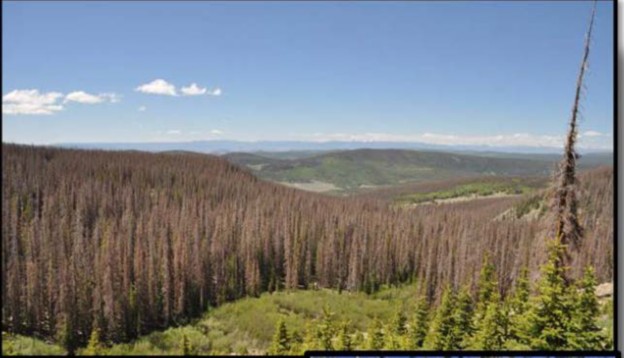
Pictures such as the one above is entirely too frequent in Colorado and are offensive to the Organizations. While the Proposal identifies that trees and forests serve as a sink for possible negative impacts of climate change, this position is based on the fact that the forest is healthy. This position simply is not relevant in Colorado as the overwhelming portion of Colorado forests area dead and unlike live trees, dead trees don’t serve as a sink for anything. In addition to the negative impacts that poor forest health has had on a huge amount of natural resources in Colorado, the dead and falling trees are probably the single largest management challenge that is encountered by the recreational community. When these foundational issues are not addressed, the Organizations are concerned about the scientific foundation for much of the Proposal as best available science is a critical tool in developing planning and management of public lands.
6b. Much of the recommended management direction in the Proposal completely conflicts with SBEADMR determinations
The Organizations would be remiss if the immediate and direct conflict with much of the recommended management in the Proposal has with the Spruce Beetle Epidemic and Aspen Decline Management Response (SBDEARMR) process that was recently concluded on the GMUG18 was not addressed. Almost every recommendation in the Proposal would change or complicate management of forest health issues in the Proposal area, but no basis for these changes is addressed. This management is critical in preserving recreational opportunities as poor forest health is the single largest challenge facing the recreational community in Colorado. The Organizations vigorously supported the proactive and vigorous response of GMUG planners to the poor forest health issue that now plagues so much of Colorado. The Organizations believe this management is critically needed to bring balance back into the forest and protect all resources in the future. If there is a management recommendation that is provided in the Proposal that conflicts with the SBDEARMR it should be specifically addressed.
The following map reflects the priority treatment areas identified in the SBEARMR project in the Proposal area:
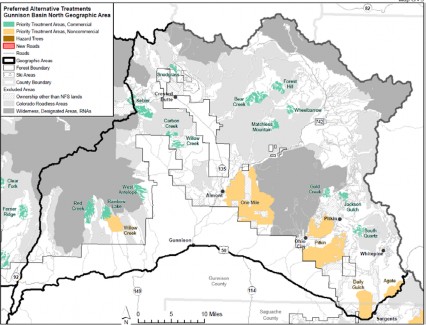
While almost every area in the Proposal is a priority management treatment area in the SBEADMR project, these conflicts are only recognized in three of the management designations. Again, this causes serious concern for the Organizations regarding the scientific basis for the Proposal and any claimed benefits.
6c. Best available science on water quality does not support the management direction in the Proposal.
Throughout the Proposal the protection of water quality is identified as a management objective in the Proposal, but at no point is the strong negative relationship between poor forest health and water quality compared to the management recommendations in the Proposal. Best available science on this relationship has consistently identified the compelling need for active management of poor forest health to protect water quality. Strong correlation between water quality and production in areas impacted by the pine/spruce beetle epidemic is reflected in the following summary of the situation:
“Changes in annual water yield following beetle kill were variable (Figure 4). We expected an increase in annual water yield with increased beetle killed area. Instead, we detected water yield decreases, that is less water yield than before the beetle kill. With further examination, we found that not all forest stands infected by beetles are equal.”19
Colorado State Forest Service has provided decades of high-quality site-specific information on the negative impacts on water quality from the mountain pine beetle epidemic, and actually devoted their entire 2016 annual report to the issue. The highlights of the 2016 report are as follows:
-8% of ALL trees in Colorado are dead and the rate of mortality is increasing;20
– the total number of dead trees has increased 30% in the last 8 years;21
– Research has shown that in mid-elevation forests on Colorado’s Front Range, hillslope sediment production rates after recent, high-severity wildfire can be up to 200 times greater than for areas burned at moderate to low severity.22
– A 2011 study involved monthly monitoring of stream chemistry and sediment in South Platte River tributaries before and after fire and showed that basins that burned at high severity on more than 45 percent of their area had streams containing four times the amount of suspended sediments as basins burned less severely. This effect also remained for at least five years post-fire.23
– High-severity wildfires responsible for negative outcomes are more common in unmanaged forests with heavy fuel loads than in forests that have experienced naturally recurrent, low-intensity wildfires or prior forest treatments, such as thinning. It is far easier to keep water in a basin clean, from the source headwaters and through each usage by recipients downstream, than to try and restore water quality once it is degraded.24
–During 2016’s Beaver Creek Fire, which burned 38,380 acres northwest of Walden, foresters and firefighters were given a glimpse into likely future challenges facing wildfire suppression and forest management efforts. These include longer duration wildfires due to the amount and arrangement of heavy fuels. Observations from fire managers indicated that instead of small branches on live trees, the larger, dead fuels in jackstraw stands were the primary driver of fire spread…. “The hazards and fire behavior associated with this fuel type greatly reduce where firefighters can safely engage in suppression operations”25
A copy of this report and many other detailed planning tools addressing the impacts of not managing for poor forest health is available on the state forest service website. 26 Additionally, the critical need for active management of watersheds as a result of the mountain pine beetle impacts is also highlighted in the Front Range Fuels treatment partnership. 27 This group highlighted impacts as follows:

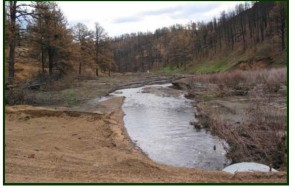
The front range partnership outlined management needed as follows:
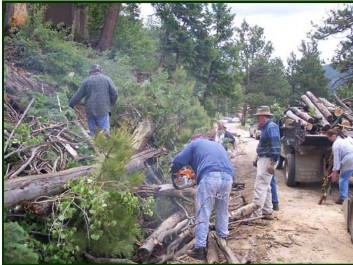
Given the strong corollary between best available science regarding the need for active management of water resources in poor forest health areas, the basic direction of management prescriptions in the Proposal is very concerning. Any recommendation in the Proposal should be reflecting best available science regarding the need for the management in the area and what the actual on the ground conditions and challenges are for that area.
7. Conclusion
The Organizations have serious concerns about many of the positions that are being taken in the Proposal such as not impacting multiple use access to the area and as a result must vigorously oppose the Proposal. This simply is untrue as many of the areas that are would be closed to multiple use in the Proposal are currently open to multiple use and represent important expansion areas for these uses in the future. Additionally, large amounts of the Proposal management directly conflict with the numerous inventory of characteristics of areas by the agency, such as the roadless inventories of the upper Gunnison Valley, which is concerning given the huge amounts of public input that were received during these agency inventories.
Further many of the recommendations now made in the Proposal, are directly in conflict with the conclusions Congress has made about the suitability of these areas for this type of management, such as the areas north of the Uncompahgre Wilderness that were specifically released back to multiple use management in the 1980 Colorado Wilderness Legislation. Other Congressional mandates, such as the lack of buffer areas around many of the Wilderness areas simply are never addressed.
Please feel free to contact Scott Jones, Esq. if you should wish to discuss any of the issues that have been raised in these comments further. His contact information is Scott Jones, Esq., 508 Ashford Drive, Longmont Colorado 80504; phone 518-281-5810; email Scott.jones46@yahoo.com.
Scott Jones, Esq.
COHVCO/TPA Authorized Representative
CSA President
Don Riggle
Director of Operations
Trails Preservation Alliance
- See, Proposal at pg. 9.
- For a detailed version of this map, please see https://www.fs.usda.gov/Internet/FSE_DOCUMENTS/stelprdb5397031.pdf
- https://www.fs.usda.gov/detail/gmug/landmanagement/projects/?cid=fseprd488168
- See,Proposal at pg.10.
- https://www.western.edu/sites/default/files/media/raw/Fossil%20Ridge%20Wilderness.pdf
- See, PL 103-77 @ §3(2)(3)
- See, Proposal at pg. 44.
- See House Report 96-617 paragraph 9. A copy of this report has been attached for your convenience.
- See, Douglas Macintyre; “American Ghost Towns of the 21st Century”; The Wall Street Journal; April 11, 2011
- See, USDA Forest Service; “GMUGNF-Job and Income Contributions for 2014 at a glance”; September 2016 Acomplete copy of this research is available herehttps://www.fs.fed.us/emc/economics/contributions/documents/at-a-glance/published/rockymountain/AtaGlance-GMUG.pdf
- See, Department of Commerce; Bureau of Economic Analysis; “Outdoor Recreation Satellite Account: Prototype Statistics for 2012-2016”; February 14, 2018 at pg. 2.
- See, USDA Forest Service; National Forest Support a Recreation Economy- a complete study copy is available here: http://blog.nwf.org/2014/07/national-forests-support-recreation-economy/
- See, Holmes & White;National & Community Market Contributions of Wilderness; Society & Natural Resources; An International Journal; Volume30 2017
- See, UDSA Forest Service; White & Stynes;Updated Spending Profiles for National ForestRecreation Visitors byActivity; Joint venture between USDA Forest Service Pacific Northwest Research Station and Oregon State University; November 2011 at pg. 6.
- See, USDA Forest Service, National Visitor Use Monitoring; “National Visitor Use Monitoring Survey Results; National Summary Report; Data collected FY 2012 through FY 2016”; 2016 at pg. 1.
- See, USDA Forest Service; 36 CFR Part 294 Special Areas; Roadless Area Conservation; Applicability to the National Forests in Colorado; Final Environmental Impact Statement; May 2012 pg. 19
- See, USDA Forest Service; National Visitor Use Monitoring Results; GMUG National Forest; Round 3; last updated January 26, 2018 at pg. 9.
- https://www.fs.usda.gov/project/?project=42387
- See, Stedneck et al; Effects of Pine Beetle Infestations on Water Yield and Water Quality at the watershed scale in Northern Colorado;
- http://csfs.colostate.edu/2017/02/15/800-million-standing-dead-trees-colorado/
- 2016 Forest Health Report at pg. 6
- 2016 Forest Health Report at pg. 24
- 2016 Forest Health Report at pg. 24
- 2016 Forest Health Report at pg. 24
- 2016 Forest Health Report at pg. 5
- https://csfs.colostate.edu/media/sites/22/2017/02/CSU_304464_ForestReport-2016-www.pdf
- See, Le Master et al; PROTECTING FRONT RANGE FOREST WATERSHEDS FROM HIGH-SEVERITY WILDFIRES AN ASSESSMENT BY THE PINCHOT INSTITUTE FOR CONSERVATION FUNDED BY THE FRONT RANGE FUELS TREATMENT PARTNERSHIP; a copy of this document is available here. http://www.frftp.org/research_education
